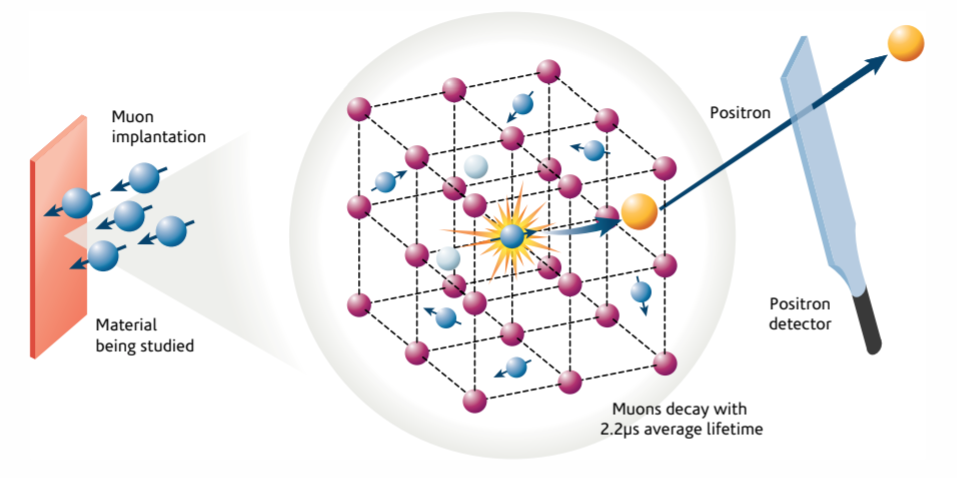name: inverse layout: true class: center, middle, inverse <div class="my-header"><span> <a href="/training-material/topics/" title="Return to topic page" ><i class="fa fa-level-up" aria-hidden="true"></i></a> <a href="https://github.com/galaxyproject/training-material/edit/main/topics//slides/.html"><i class="fa fa-pencil" aria-hidden="true"></i></a> </span></div> <div class="my-footer"><span> <img src="/training-material/assets/images/GTN-60px.png" alt="Galaxy Training Network" style="height: 40px;"/> </span></div> --- <img src="/training-material/assets/images/GTNLogo1000.png" alt="Galaxy Training Network" class="cover-logo"/> <br/> <br/> # Introduction to Muon Spectroscopy <br/> <br/> <div markdown="0"> <div class="contributors-line"> <ul class="text-list"> <li> <a href="/training-material/hall-of-fame/anish-mudaraddi/" class="contributor-badge contributor-anish-mudaraddi"><img src="https://avatars.githubusercontent.com/anish-mudaraddi?s=36" alt="Anish Mudaraddi avatar" width="36" class="avatar" /> Anish Mudaraddi</a> <li> <a href="/training-material/hall-of-fame/elichad/" class="contributor-badge contributor-elichad"><img src="/training-material/assets/images/orcid.png" alt="orcid logo" width="36" height="36"/><img src="https://avatars.githubusercontent.com/elichad?s=36" alt="Eli Chadwick avatar" width="36" class="avatar" /> Eli Chadwick</a> <li> <a href="/training-material/hall-of-fame/patrick-austin/" class="contributor-badge contributor-patrick-austin"><img src="https://avatars.githubusercontent.com/patrick-austin?s=36" alt="Patrick Austin avatar" width="36" class="avatar" /> Patrick Austin</a> <li> <a href="/training-material/hall-of-fame/leandro-liborio/" class="contributor-badge contributor-leandro-liborio"><img src="https://avatars.githubusercontent.com/leandro-liborio?s=36" alt="Leandro Liborio avatar" width="36" class="avatar" /> Leandro Liborio</a></li> </ul> </div> </div> <!-- modified date --> <div class="footnote" style="bottom: 8em;"> <i class="far fa-calendar" aria-hidden="true"></i><span class="visually-hidden">last_modification</span> Updated: </div> <!-- other slide formats (video and plain-text) --> <div class="footnote" style="bottom: 5em;"> <i class="fas fa-file-alt" aria-hidden="true"></i><span class="visually-hidden">text-document</span><a href="slides-plain.html"> Plain-text slides</a> | </div> <!-- usage tips --> <div class="footnote" style="bottom: 2em;"> <strong>Tip: </strong>press <kbd>P</kbd> to view the presenter notes | <i class="fa fa-arrows" aria-hidden="true"></i><span class="visually-hidden">arrow-keys</span> Use arrow keys to move between slides </div> ??? Presenter notes contain extra information which might be useful if you intend to use these slides for teaching. Press `P` again to switch presenter notes off Press `C` to create a new window where the same presentation will be displayed. This window is linked to the main window. Changing slides on one will cause the slide to change on the other. Useful when presenting. --- # What are "Muons"? Muons are subatomic particles that have spin 1/2, carry one elementary electric charge, and have a mass about 207 times the rest mass of the electron or 1/9th of the rest mass of the proton. Muons may be though of as "heavy electrons" or "light protons", and they are generated via nuclear reactions currently at four muon sources around the world. The ISIS Neutron and Muon Source, at the Rutherford Appleton Laboratory in the UK, is one of them. --- # What is Muon Spectroscopy? In a muon experiment, the muons are channelled into beamlines and fired towards the samples that we want to study. They are implanted into the sample and decay with an average lifetime of 2.2μs, releasing a positron in the direction of the spin of the muon at the time of decay. The positrons leave the sample and are collected by a positron detector. These detections are used to infer the behaviour of the muons and, with that, study different properties of the sample.  --- # Muon Simulations One of the main problems in Muon Spectroscopy is knowing where the muon is implanted - where it stops - inside the sample. The stopping site is influenced by many factors and knowing its location is very useful for the interpretation of muon experiments. Computer simulations can help with estimating the muon stopping site. --- # Muon Galaxy tools Muon Galaxy gives easy access to a set of software tools developed by the [Muon Spectroscopy Computational Project (MSCP)](https://muon-spectroscopy-computational-project.github.io/index.html) for simulating muon science experiments including: - approximating the muon stopping site - simulating spin dynamics of muonated structures --- ## Related tutorials --- ## Thank You! This material is the result of a collaborative work. Thanks to the [Galaxy Training Network](https://training.galaxyproject.org) and all the contributors! <div markdown="0"> <div class="contributors-line"> <table class="contributions"> <tr> <td><abbr title="These people wrote the bulk of the tutorial, they may have done the analysis, built the workflow, and wrote the text themselves.">Author(s)</abbr></td> <td> <a href="/training-material/hall-of-fame/anish-mudaraddi/" class="contributor-badge contributor-anish-mudaraddi"><img src="https://avatars.githubusercontent.com/anish-mudaraddi?s=36" alt="Anish Mudaraddi avatar" width="36" class="avatar" /> Anish Mudaraddi</a><a href="/training-material/hall-of-fame/elichad/" class="contributor-badge contributor-elichad"><img src="/training-material/assets/images/orcid.png" alt="orcid logo" width="36" height="36"/><img src="https://avatars.githubusercontent.com/elichad?s=36" alt="Eli Chadwick avatar" width="36" class="avatar" /> Eli Chadwick</a><a href="/training-material/hall-of-fame/patrick-austin/" class="contributor-badge contributor-patrick-austin"><img src="https://avatars.githubusercontent.com/patrick-austin?s=36" alt="Patrick Austin avatar" width="36" class="avatar" /> Patrick Austin</a><a href="/training-material/hall-of-fame/leandro-liborio/" class="contributor-badge contributor-leandro-liborio"><img src="https://avatars.githubusercontent.com/leandro-liborio?s=36" alt="Leandro Liborio avatar" width="36" class="avatar" /> Leandro Liborio</a> </td> </tr> <tr> <td><abbr title="These people edited the text, either for spelling and grammar, flow, GTN-fit, or other similar editing categories">Editor(s)</abbr></td> <td> <a href="/training-material/hall-of-fame/joelvdavies/" class="contributor-badge contributor-joelvdavies"><img src="https://avatars.githubusercontent.com/joelvdavies?s=36" alt="Joel Davies avatar" width="36" class="avatar" /> Joel Davies</a></td> </tr> <tr class="reviewers"> <td><abbr title="These people reviewed this material for accuracy and correctness">Reviewers</abbr></td> <td> <a href="/training-material/hall-of-fame/hexylena/" class="contributor-badge contributor-badge-small contributor-hexylena"><img src="https://avatars.githubusercontent.com/hexylena?s=36" alt="Helena Rasche avatar" width="36" class="avatar" /></a><a href="/training-material/hall-of-fame/patrick-austin/" class="contributor-badge contributor-badge-small contributor-patrick-austin"><img src="https://avatars.githubusercontent.com/patrick-austin?s=36" alt="Patrick Austin avatar" width="36" class="avatar" /></a><a href="/training-material/hall-of-fame/bgruening/" class="contributor-badge contributor-badge-small contributor-bgruening"><img src="https://avatars.githubusercontent.com/bgruening?s=36" alt="Björn Grüning avatar" width="36" class="avatar" /></a><a href="/training-material/hall-of-fame/leandro-liborio/" class="contributor-badge contributor-badge-small contributor-leandro-liborio"><img src="https://avatars.githubusercontent.com/leandro-liborio?s=36" alt="Leandro Liborio avatar" width="36" class="avatar" /></a></td> </tr> </table> </div> </div> <div style="display: flex;flex-direction: row;align-items: center;justify-content: center;"> <img src="/training-material/assets/images/GTNLogo1000.png" alt="Galaxy Training Network" style="height: 100px;"/> <div> <div> <img class="funder-avatar" src="https://avatars.githubusercontent.com/eurosciencegateway" alt="Logo"> </div> <div> </div> </div> </div> Tutorial Content is licensed under <a rel="license" href="http://creativecommons.org/licenses/by/4.0/">Creative Commons Attribution 4.0 International License</a>.<br/>